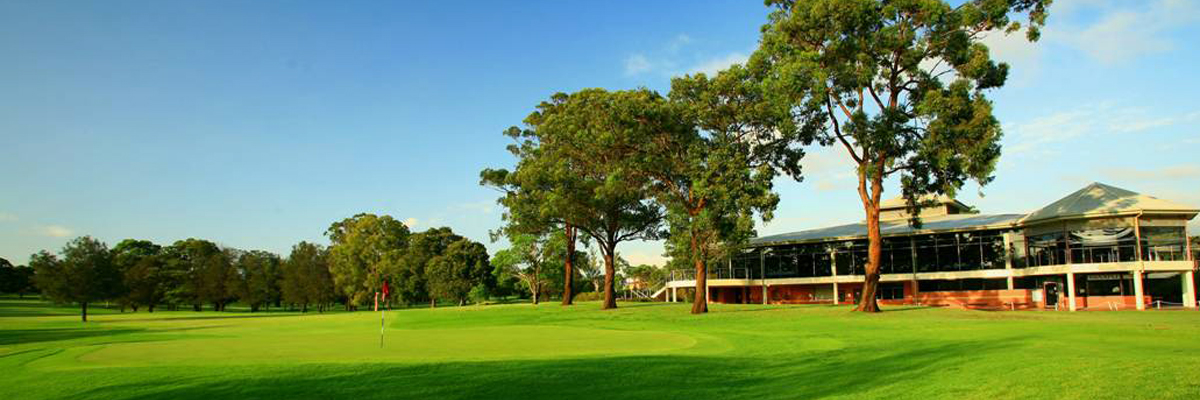About Carnarvon Golf Club | Burwood | Silverwater | Sydney

Carnarvon Golf Club began in 1927 when the game was played on an informal basis before being regularised at the first Annual General Meeting in August, 1928. The first President was Alderman W.R. Atkinson of Lidcombe Council and one of the Vice-Presidents was the Hon. J.T. Lang, Premier of New South Wales.
The course which measured 4277 yards with a bogey of 75, was situated on the northern side of Parramatta Road and covered the following area :
- Western Boundary: Wetherill St.
- Northern Boundary: Derby St.
- Eastern Boundary: Haslam’s Creek and Hill Road.
- Southern Boundary: Adderley St. Day St. then Parramatta Road to Hill Road.
The area covered by the course included vacant proposed factory sites, unmade roads, an agistment paddock of the State Abbatoirs and portion of Southian’s dairy. The greens were the natural grasses mowed at the weekends by the members’ own push mowers. The holes were jam tins.
The course was named after a large sign, visible from Parramatta Road, advertising factory sites for sale on Carnarvon Hill Estate. This sign is regarded as the first clubhouse as members drove nails into it on which to hang their coats and other paraphernalia.
The first real clubhouse, known as “the Shack, was erected in 1929 on the corner of Day and Derby Streets and comprised two rooms, one 10 feet by 10 feet for members and the other 8 feet by 8 feet for associates with a 9 feet by 4 feet verandah. In 1931 the old Auburn Ambulance Station was purchased, towed to the site and added to The Shack.
As tenure over the original course was tenuous at best a move was made to what became known as the “old course” in late 1932 with the official opening in 1933.The old course was located to the north of Fariola St. and occupied two paddocks owned by Newington State Hospital and a paddock to the south of Holker St. owned by Lidcombe Council. The lease from Newington State Hospital was for fifteen years under permissive occupancy tenure and covered tees and greens only. The greens were enclosed with post and rail fences as protection from our bovine co-tenants of the hospital dairy herd.
The clubhouse was moved to the northern side of the eastern end of Fariola St in 1933 when extensive additions and alterations were effected.
Things moved along swimmingly for the next ten years or so until the outbreak of World WarII. Our biggest disaster came on 8 March, 1943 when the clubhouse and the top paddock were taken over by the US Navy necessitating yet another move. It was decided to continue with a nine hole course consisting of the bottom paddock for seven holes with the remaining two holes in the council paddock. This became known as the Silverwater course. To accommodate a Clubhouse the committee resolved on 20 April, 1043 to purchase thecottage in Clyde St. Auburn and the adjacent eleven vacant blocks for 470 pounds Following the convention of the time it was necessary to pay 100 pounds “key money” to obtain vacant possession of the property. With renovations the cottage served as a Clubhouse until the move to the present course. The old cottage went through many years of modification, renovation, partial demolition and rebirth as a motor boat club, Auburn Businessman’s Club and is currently Dooley’s On The Water.
The move to the present course was foreshadowed as early as 1943. The new course was an amalgamation of two contiguous areas separated by Walters Rd. which originally ran through from Nottinghill Rd to Joseph St. The area between Leila St. and Walters Rd. was the Lidcombe Sports and Showground and the area between Walters Rd and Amy St was the western grazing paddock of Lidcombe State Hospital for its prize winning herd of Holstein dairy cows. The areas were amalgamated, Walters Rd closed and the area leased to Carnarvon Golf Club in 1947. The course was built between the years 1947 to 1949 to a design by Arthur East. The Clubhouse was built over the same period. Due to the difficulty in obtaining building material in the post-war years the Clubhouse was built from material obtained by demolishing the Fariola St building together with the Liverpool and Lidcombe Soldiers’ Halls.
The Clubhouse and new course were opened in December, 1949. Additions and renovations kept the building functional until 1998 when the Club came under increasing pressure to bring the structure up to the required standards. The cost involved was considered uneconomic considering the condition of the underpinnings. The Board voted to build a new Clubhouse and then demolish the old building. This was completed in December, 1999.
Our present course presented a horticultural challenge to the earlier Committees and course superintendents as they battled with an area of poor clay based soil, gravel patches and rock outcrops. The Committee tendered for and won the contract to remove manure from the holding paddocks at Flemington Saleyards on the site of the present Flemington Markets. The contract ran from 1957 to 1963 and most fairways were covered to a depth of six to eight inches with mostly sheep manure. This was done half a fairway width at a time to enable play to continue. This combined with automatic fairway and greens watering of more recent years coupled with extensive drainage projects, has produced the lush course we have today.
To quote the late C.W.Phillips President, from his address at the A.G.M. of 27th March, 1943 :-
“Finally we have a good Club built by ourselves for ourselves and those we are happy to have with us and the old Carnarvon spirit will win through notwithstanding”